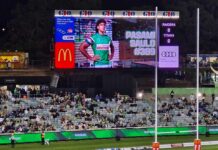Outdoor digital displays are benefiting from developments in both hardware and software. Gone are the days when a waving American flag graphic or scrolling text reading “come on in” were enough to get a customer’s attention.
Sign shops today are tasked with helping their clients find bigger, better, and bolder ways for their electronic displays to stand out.
The end goal is to be different, but all outdoor display projects should start at the same place—finding out just what a client wants to accomplish with their display. David Rycyna, CEO of Cirrus LED Systems, suggests having clients ask themselves, “What do I want to put up there? How do I want to use this? What’s going to be best for my business?”
On the hardware side of those considerations, shops are no longer bound by a rectangular or square shape. “The hardware is becoming more and more flexible,” says Rycyna. “The hardware is no longer the limitation; it’s the limitation of that installer/integrator and how they want to put things together.”
The shape of the digital sign will, of course, affect the content and how it’s displayed, so shops should also get an idea of what a client wants to put on their display.
Content like scrolling text or a full-color graphic of a hamburger will require screens with different resolutions and different price points. By knowing ahead of time what a business wants to display, shops can help them avoid purchasing a display that is too small or doesn’t have the right pixel pitch.![]()
Location of the sign should come up next since it too has a big impact on the screen resolution.“If you’re at the side of a highway, you don’t even want to spend money on the really low pixel pitch displays, in other words high-resolution, because it’s just lost on your audience because they can’t see it,” says Rycyna. “They’re going too fast from too far away. So there are optical limitations that you’re dealing with.”
Local regulations on outdoor digital displays are a final consideration. Outdoor displays are regulated in ways that indoor ones are not, and sign shops should be aware of any restrictions before beginning a project. “Every single town has a different expert who wrote a different set of rules,” says Rycyna. “The conversation starts focusing more on what you can’t do than what you can do.”
When the goals, parameters, and details of an outdoor digital sign project are determined, shops and clients can start to look at content. Technology and software have come a long way, and there are more tools than ever to generate content. “You hate to say it,” says Rycyna, “but it’s almost like an arms race of who’s [going to] put cooler stuff up on their screen.”
Shops should offer a software with plenty of content options—both for advertising and entertainment purposes. Clients should have no problem taking these features and running with them. “The user doesn’t have to invent it. They just have to see it there and say, ‘Oh, I’ve got a great idea for that,’” says Rycyna. “Doing things that are atypical to standout—that’s a big part of it.”![]()
And new advances like the Cloud are making it even easier for your clients to use the features available to them and to update their sign from any device with a Web connection.
“It’s a sign. It’s there to attract attention, and it’s there to advertise a business,” says Rycyna. “What they have on it, moreso than ever, is a reflection of who they are as a business and their brand.”
By Ashley Bray
All photos: Cirrus LED Systems.










